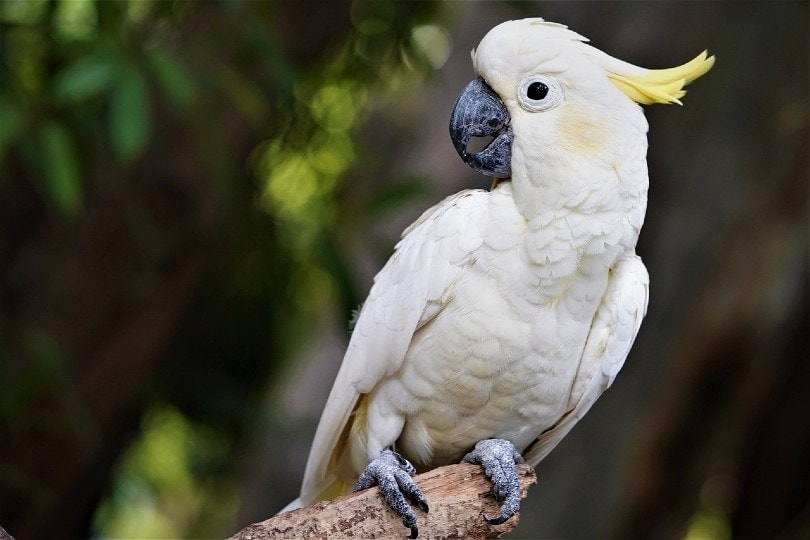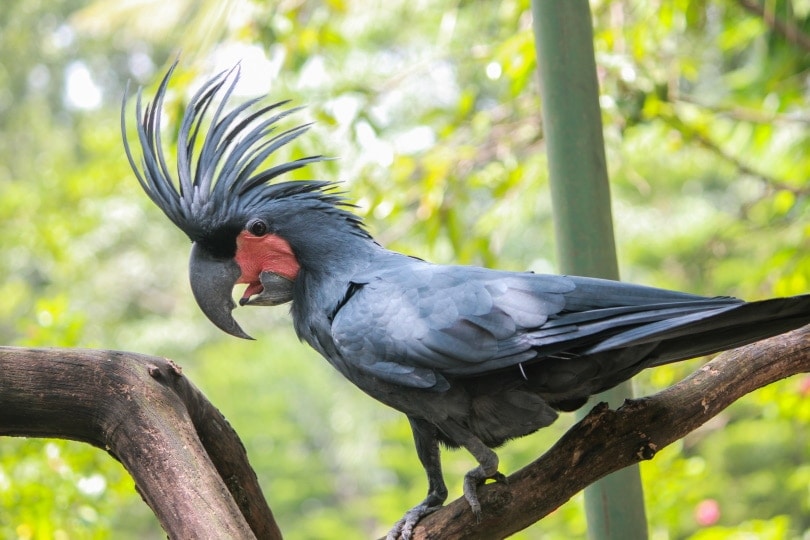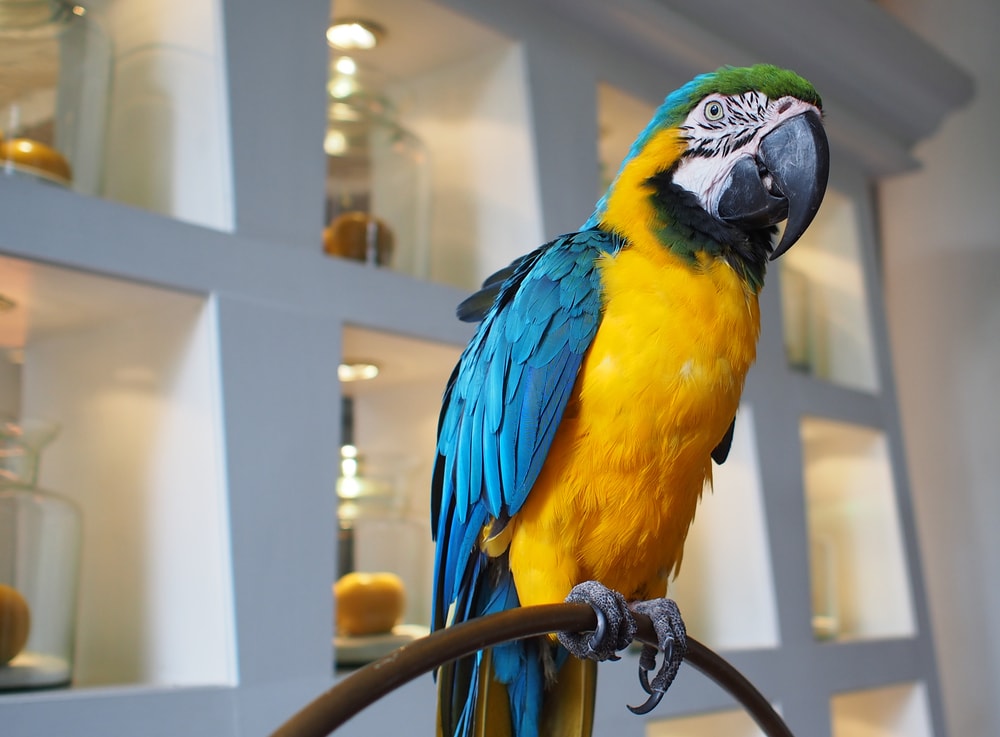Cockatoo vs. Parrot: Main Differences (With Pictures)

Updated on

Click to Skip Ahead
Some of the most popular birds that people keep as pets are members of the cockatoo and the parrot families. Their intelligence, vibrant plumage, and social natures endear them to experienced and novice bird owners across the world.
If you’re new to owning birds, you might not realize that cockatoos are parrots. The parrot family, or members of the order Psittaciformes, includes just under 400 species of birds that all have distinctive curved beaks and zygodactyl feet. These include cockatoos, parakeets, macaws, cockatiels, and even the flightless and critically endangered kākāpō.
While cockatoos and parrots are both members of the same family, there are many differences between them. Their size, appearance, and coloring all differ, but they also have different skills and personalities. This guide will introduce you to cockatoos and parrots, the differences between them, and why all cockatoos are parrots but not all parrots are not cockatoos.
Visual Differences

At a Glance
- Average height (adult): 12–27 inches
- Average weight (adult): 10–30 ounces
- Lifespan: 10–80 years
- Common Colors: Mostly white or black with red, pink, or yellow feathers
- Grooming needs: Low
- Family-friendly: Older children and experienced bird owners
- Other pet-friendly: Birds only
- Trainability: Intelligent but can be sensitive and stubborn
- Average height (adult):5–40 inches
- Average weight (adult):25–56 ounces
- Lifespan: 5–90 years
- Common Colors: Green, red, blue, yellow, and orange
- Grooming needs: Low
- Family-friendly: Varies depending on the species
- Other pet-friendly: Birds only
- Trainability: Very intelligent but can be stubborn depending on the species
Cockatoo Overview
If you’re familiar with cockatoos already, you might be aware that they are actually a sub-family of parrots. The cockatoo is a superfamily that falls under the order Psittaciformes, the same as parrots. They belong to the Cacatuidae family, which includes 21 different species.
While they are considered to be parrots, there are plenty of differences that set them apart from other parrot species.

Personality
The cockatoo might not be known for their ability to talk, but like other parrots, they are still considered to be quite intelligent. When paired with an experienced and dedicated owner, cockatoos can be taught a variety of tricks, including how to dance.
However, except for cockatiels, cockatoos aren’t beginner friendly at all. They’re affectionate, but they’re also incredibly demanding, especially when they’re seeking your attention and feel like they’re being ignored.
They don’t just need plenty of room in their cage; they also need many toys and activities to keep them entertained. You’ll need to give them time to fly around outside of the cage too. When they’re not given enough things to do, such as forage for food, fly around, or explore, you can expect them to develop bad habits like destructive or aggressive behavior, both toward your furniture and themselves.
Cockatoos are the loudest members of the parrot family, with a harsh, penetrating voice that makes them unsuitable for apartments, lest you annoy your neighbors.
Their personality can vary between species, with the Moluccan Cockatoo being one of the loudest and the Umbrella Cockatoo being known for their clinginess but less high-strung temperament.
Appearance
Cockatoos are easy to distinguish from other parrots. Their appearance can vary depending on their species, but they all share similar traits. The most obvious difference is the color of their plumage, with white or black being the most common colors.
All cockatoos can be recognized by the crest of feathers on top of their heads. This crest is adjustable, and cockatoos are known for using it to show off to their owners or other birds and to make themselves look bigger. They’re the only parrot family with this crest.
Most cockatoos are also larger than other parrot species, even when they’re not using their stylish crest to look bigger than they are. The cockatiel is the only exception, being the smallest of the cockatoo family.

Habitat
Unlike the rest of the parrot family, cockatoos aren’t spread throughout all the tropical and subtropical areas in the world. Their native habitat is more limited and generally confined to Australia, Indonesia, and the Philippines.
Since they’re incredibly popular pets, though, captive cockatoos can be found around the world outside of their native environment. Many of them are also surrendered to shelters because inexperienced bird owners struggle to keep up with their needs.
Suitable For:
Except for the cockatiel, cockatoos aren’t suitable for novice bird owners or families with young children. They require a great deal of time outside of their cage, plenty of attention, and many toys to keep them entertained.
These birds are prone to developing bad behavior like biting if they’re not socialized properly. Cockatoos can also develop habits like feather destruction and self-mutilation, which can be difficult for inexperienced owners to handle.
They can be taught to get along with other pets, but it’s recommended that you keep them with other cockatoos. Dogs and cats are predator animals, and your cockatoo might feel threatened by their presence.
- Intelligent
- Can be taught tricks
- Enjoys dancing
- Excellent companion for experienced bird owners
- Loud
- Prone to behavioral issues
- Not suitable for owners with allergies
- Lifelong commitment
Parrot Overview
You might assume that parrots are only the flashy red, green, or blue birds that can mimic human speech. However, the parrot family encompasses 390 different species, including the cockatoo. They come in all sizes, shapes, temperaments, and colors. Parrots can be recognized by their bright plumage, curved beaks, and zygodactyl feet.
They can be members of the Cacatuidae family, like the cockatoo, but can also be part of the two other superfamilies in the order Psittaciformes. Outside of the cockatoo family, parrots encompass the Psittacidae (“True” Parrots) family and the Strigopidae (New Zealand Parrots) family.
Cockatoos might be parrots, but the parrot family includes more birds than just the cockatoo superfamily.

Personality
Along with members of the Corvidae family like crows, ravens, and jays, parrots are among the most intelligent bird species in the world. They can mimic human speech and have a knack for picking up tricks. However, the personalities of different parrot species can vary depending on the individual bird.
Many parrots can be independent and loud, while others are quiet and laidback. Some parrots might be affectionate when they’re younger but become more aloof or aggressive when they’re older, which is why it’s important to consider the species carefully before getting a pet bird.
Most of all, many parrot species are incredibly social. While they might not get along with cats or dogs, most parrots feel the most comfortable when they have other parrots to interact with. In the wild, parrots generally live in flocks of up to 30 birds. This is why many parrots can be demanding of your attention.
Appearance
Compared to the cockatoo, most parrot species are smaller and more brightly colored. They have the same curved beak and intelligence as other members of the parrot family, but most of them lack the distinctive crest that the cockatoo family is known for.
The most common colors that parrots include green, red, and blue, with yellow or gold feathers. This is due to the Macaw parrots—such as the Scarlet Macaw or the Blue-and-Yellow Macaw—being the most striking and most easily recognized members of the parrot family. Another popular parrot is the Grey Parrot, which despite their less-striking gray plumage, are renowned for their stellar ability to mimic human speech.

Habitat
While the cockatoo family is limited to only a few areas of the Pacific, the rest of the parrot family is far more widespread. The area that each parrot is native to depends on their species, but they can be found in all the tropical and subtropical regions in the world. These include South and Southeast Asia, Central and South America, Africa, Australia, and Oceania.
Suitable For:
There are so many members of the parrot family that there’s one for all bird lovers. Unfortunately, they’re not all suitable for beginners, and the large parrots are often recommended for experienced bird owners only. Many parrots are also not suitable for families with other pets like cats and dogs or with young children, as the birds might feel threatened by the presence of a predator or the noise level.
Since many parrots are incredibly long lived and frequently outlive their owners, they need a dedicated owner who’s willing to make a lifelong commitment to their care.
- Easy to train
- Many species can be taught to speak
- Gets along with other parrots
- Eye-catching and vibrant plumage
- Lifelong commitment
- Many species recommended for experienced bird owners only
- Can be demanding
Which Breed Is Right for You?
Cockatoos can be distinguished from parrots by their less-vibrant coloring and the crest of movable feathers on the top of their heads. That said, they are a member of the parrot family and encompass 21 species within the 390 different species of parrots. As a member of the order Psittaciformes, cockatoos are highly intelligent, sociable, and easy to train, just like other parrot species. They also share similarities in their appearance, such as their curved beak and zygodactyl feet.
While all cockatoos are parrots, they’re only a subfamily of the parrot genus. This means not all parrots are cockatoos. Other parrot species include macaws, parakeets, lovebirds, lorikeets, and Amazons.
Most parrots can be distinguished from cockatoos by the lack of a crest on their heads and the vibrant colors of their plumage. They also tend to be smaller and quieter than cockatoos.
All parrot species, including cockatoos, require dedicated owners willing to put in the time to learn about the species and provide plenty of attention and entertainment. Parrots are lifelong companions that build unwavering bonds with their owners and can be affectionate and playful, with a love for learning new tricks.
See Also:
- Are Crows Smarter Than Parrots? Bird Intelligence Explained
- Parakeet vs Lovebird: Vet Reviewed Differences (With Pictures)
Featured Image Credit: (L) Moonfullofstars, Shutterstock | (R) Eko Budi Utomo, Shutterstock











